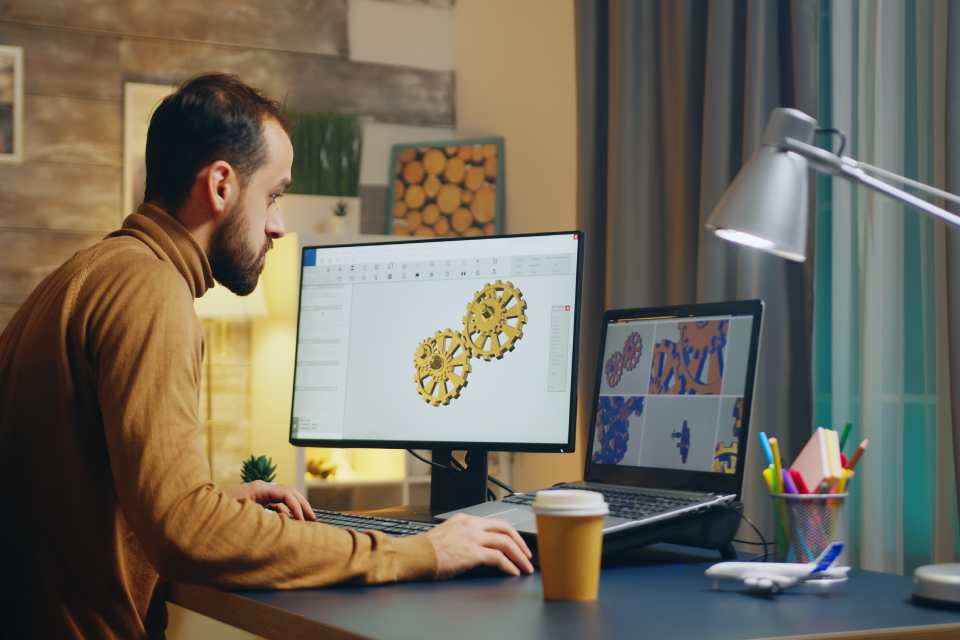Computer image processing has become an omnipresent element in our daily lives, influencing everything from photography and cinema to medicine and advertising. In an increasingly visual world, the ability to digitally manipulate and enhance images has become increasingly important, with increasingly advanced software and apps that allow images to be modified in seconds for mobile devices. Here we show you how this treatment of this type of files works.
What Is A Computer Image?
A digital image or computer image is a two-dimensional representation of an image created from a numerical matrix, usually in binary format (made up of ones and zeros). The nature of the image can be static or dynamic, thus determining whether it is a matrix image (or bitmap) or a vector graphic, as we will see later.
There are various ways to obtain digital images, such as scanning an image or photographing it for digitization. They can also be drawn or generated from programs or generated by AI, or by rendering.
Furthermore, you should know that these computer images can be easily modified using the appropriate software; that is, they are not immutable. For example, you can use different editing tools, filters, deletions, resizing, etc.
Once the image is created or modified, it can be stored in a given format. There are many image formats, each with its characteristics. For example, we have some cases like JPG, PNG, BMP, SVG, etc. Each format will have a series of characteristics for its storage and subsequent editing or viewing.
Generally, stored image files have several parts, such as:
- Header: data such as attributes that indicate the dimensions of the image, the type of encoding (format), etc., are stored in it.
- Binary image: this is information about the image itself, that is, how the image is formed in terms of shape, colours, etc. This can vary its structure depending on the format.
- Metadata: The files also include a metadata section, that is, additional information that can be very varied depending on the format. For example, they can be the sensitivity to the scale, date of modification, who created it, and even some data commonly used by digital cameras or by some programs.
Characteristics Of A Digital Image
The fundamental characteristics of a digital image include:
- Resolution refers to the number of pixels that make up an image. It is usually expressed as the number of pixels in width and height, for example, 1920×1080 px. Resolution affects the quality and clarity of the image, with higher resolution being synonymous with greater detail.
- Colour Depth (Bits per Pixel): indicates how many bits are used to represent the colour of each pixel. For example, a colour depth of 8 bits per channel for RGB means that there are 8 bits (256 possible values) to represent the red, green, and blue components of each pixel. A greater colour depth allows a wider range of colours to be represented, providing greater chromatic richness and detail in the image.
- Colour Space: describes how colours are represented and organized in an image. Common examples include RGB (Red, Green, Blue), CMYK (Cyan, Magenta, Yellow, Black), and grayscale. Colour space influences accurate colour reproduction and is crucial in applications such as graphic design, printing and photography.
- Aspect Ratio: It is the proportion between the width and height of an image. It can be expressed as a ratio (for example, 16:9) or as a fraction (for example, 4/3). The aspect ratio determines the shape and visual appearance of the image, which is essential when viewing screens and projections.
- File Size: This is the amount of space an image takes up in digital storage. It is measured in bytes, kilobytes (KB), megabytes (MB), or other units. File size influences the efficiency of image storage, transmission and processing.
- File Format: Specifies how image data is stored and organized. Examples include JPEG, PNG, GIF, and TIFF, among many others, which can be proprietary or free, compressed or uncompressed. Different formats have specific advantages, such as lossless compression (PNG), loss-efficient compression (JPEG), or support for animations (GIF).
- Metadata: This is additional information incorporated into the image, such as the date of creation, geographical location or details of the camera used. Metadata is useful for organizing and categorizing images, as well as providing contextual information about the capture.
- These characteristics are essential for understanding and working with digital images, as they impact the visual quality, manipulation, transmission and storage of visual information.
Types Of Images According To Training
Depending on the formation of the image and its file, we can find two fundamental types that you should know, such as:
bitmap
A bitmap or raster, also called a matrix image, is a set of data that represents a rectangular grid of pixels or coloured dots. This matrix can be viewed or modified, as well as created using drawing software.
Their height and width in pixels commonly do characterization of bitmap images (although it can also be done in other ways), as well as their colour depth in bits per pixel. Depth is what determines the number of different colours that can be stored in each point or pixel. That is the higher the bit depth, the better the quality of the image or, at least, the richer the color range it can have.
It is also important to note that each point or pixel that makes up a bitmap contains colour information independently, represented by separate channels. These colours can be in different formats, such as the well-known RGB, CMYK, LAB, etc. Even some more advanced bitmaps can also include a transparency channel or layer with the same depth as the colors, thus allowing different levels of transparency. The latter is used in advanced files such as PNG or TIFF. Since other formats, such as BMP, JPG, etc., do not support transparency, they are simpler, simply showing the pixels with the corresponding colour to make up the image.
Bitmap images have a limitation compared to vector graphics. Its dimensions can only be changed with a notable loss of quality. They can be expanded with quite significant losses in quality, and they can also be reduced; in this case, this loss is less noticeable. Therefore, the resolution at which the bitmap is created is essential. In both the editing apps and the devices that capture these images, you can modify the resolution in the settings. For example, you can choose to make it a 512×512 px bitmap, 1280×720 px, etc. The higher the resolution, the more size it will take to store the file, but it will also have greater detail due to the greater number of pixels.
Bitmap graphics store the colour of each pixel in the array in their binary image portion of the file, along with the header and metadata. For this reason, bitmaps are widely used to capture digital photograph drawings in well-known app programs such as Paint, Corel PaintShop, Krita, etc.
Additionally, it should be said that these bitmaps can be converted from one format to another using the appropriate software. They could be compressed so that the images take up less space; that is, they are lighter and take less time to load, although this could lead to some quality loss. You could also transform a bitmap into an image in vector format. Converting a bitmap to a vector graphic is known as vectorization, while the reverse process of transforming a vector graphic into a bitmap is known as rasterization.
Vector Graphic
A vector image, also called a vector graphic, is a digital representation that is composed of geometric objects, such as segments, polygons, arcs, polylines, ellipses, circles, Bézier curves, designs, text (TrueType or FreeType), and walls, each one defined by mathematical attributes such as shape, position, angle, colour, etc. This allows for much more dynamic computer images than bitmaps.
Therefore, we have a different type of image than what we have seen before in bitmaps, which is simply a matrix of pixels with their colour information. The main advantage of vector graphics is its ability to resize an image without experiencing loss of quality. Therefore, you can create an image at a given size and then scale it to the desired size without these loss problems. In addition, they allow you to manipulate, stretch and transform images in a relatively simple way. These capabilities are due to the fact that they do not store pixels and their colour in a map or matrix but instead store information in the binary image of the objects that make up the image, so by simply changing the size attribute, they can be enlarged without loss.
Thanks to this dynamism, vector graphics are more used in images for CAD programs, for images in PostScript, PDF documents, for creating typography or fonts TrueType, OpenType, PostScript, etc., as well as for video games that need to adapt to the size or screen resolution, for websites, advertising, printing, cutting plotters, CAM and CNC machines, etc.
Vector graphics file formats can also be varied, as in the case of bitmaps. For example, we have some well-known formats, such as SWF, SVG, and VML, among others. Among the programs for processing this type of image, we have examples such as Inkscape, InDesign, CorelDRAW, Adobe Illustrator, etc.
Finally, it should be noted that vector graphics can also include transparencies like bitmaps and that they have some other advantages over bitmaps, such as:
- They require less storage space since vector information is simple compared to bits and channels.
- They do not lose quality when resized, allowing unlimited scaling.
- Some formats support animation.
- However, it also has its disadvantages compared to bitmaps, such as the following:
- They are not suitable for encoding real-world photographs or videos such as those captured by cameras, scanners, etc.
- The data that describes the vector graphic requires processing, which can slow down rendering on screens or printers. And, even if an image is constructed with vector graphics, its display must ultimately be translated into pixels on screen or in print.
Also Read: What Is Color Psychology And What Is It For?
Types Of Images According To Their Compression
Image compression is an essential process in the management of visual data, allowing file sizes to be reduced without significantly losing image quality, although whether or not there is a loss will depend on the type of technique used for compression. However, making an image less heavy or making the file take up less storage space can have advantages for use on websites where you do not want to slow down loading as a result of these images or to save space on storage media.
Within images with compression, we can highlight techniques or algorithms such as:
- Run-Length Encoding (RLE): It is a simple but effective technique for compressing images, especially useful for images with solid colour regions. In this method, repetitive sequences of pixels are encoded by representing the pixel value and the sequence length. For example, a row of white pixels (255) in an image could be encoded as “255, 10” if there are ten consecutive pixels with the same value. Although RLE is effective in certain scenarios, its performance may be limited in images with more complex colour and texture variations, as it does not explore more sophisticated patterns.
- JPEG (Joint Photographic Experts Group): is a widely used image compression standard. Unlike RLE, JPEG uses a lossy compression approach, meaning some visual information is lost but allows for greater compression. The JPEG algorithm is based on discrete cosine transform (DCT) and quantization. In the JPEG process, the image is divided into blocks, and DCT is applied to each block to convert spatial information into frequency information. Quantization is then performed, where the DCT values are reduced to remove redundant information. The amount of loss is controlled by the quality selected during the compression process. Although JPEG is highly efficient in terms of compression, the loss of information can be noticeable, especially when aggressive compressions are performed. Additionally, it is not ideal for images with areas of solid colour or fine details.
- PNG (Portable Network Graphics): This is another common format that uses lossless compression. Unlike JPEG, PNG is ideal for images with areas of solid colour, transparency, and sharp details. It uses a compression algorithm based on prediction and filtering. In PNG, a series of filters are applied to each line of pixels to reduce redundancy before compression. Lossless compression makes PNG preferred in situations where visual fidelity is crucial.
- GIF (Graphics Interchange Format): It is known for its ability to store animated images, but it is also an efficient compression format for static images. It uses the Lempel-Ziv-Welch (LZW) compression method, which searches for repetitive sequences of data and replaces them with shorter codes. Although GIF offers efficient compression, it is best suited for images with a limited colour palette, as it can only represent up to 256 colours.
The Computer Image Processing Process
Computer image processing refers to the set of techniques and algorithms used to manipulate digital images through the use of a computer system. This field combines principles of engineering, mathematics, statistics, and computer science to analyze, modify, and enhance images from various sources, such as photographs, scanners, digital cameras, and MRIs, among others.
The applications of this image processing can be for different uses, such as capturing images, editing or modifying them, generating moving images, inserting them into video games, virtual reality, augmented or mixed reality, etc.
Regarding the techniques used for computer image processing, it is worth highlighting:
- Image Capture: Digital images are acquired using capture devices such as digital cameras, scanners or other sensors. These images, represented as arrays of pixels, are the basis of image processing.
- Pre-processing: Before applying specific techniques, pre-processing is often performed to improve image quality. This may include operations such as colour correction, contrast adjustment, noise removal, and sharpening.
- Filtering: Various filters are used to highlight, soften or remove certain details from an image. Filters can be linear or non-linear and are applied depending on the specific treatment objectives.
- Geometric transformations: allow you to modify the geometry of an image, such as rotating, scaling or translating. These transformations are useful for aligning images, correcting distortions, and making spatial adjustments.
- Segmentation: consists of dividing an image into meaningful segments or regions with similar characteristics. Segmentation is essential for pattern recognition, object detection, and content analysis.
- Pattern Recognition: Machine learning algorithms and computer vision techniques are used to identify patterns and objects in images. This is essential in applications such as facial recognition, object classification, and medical image analysis.
- Image Restoration: The aim is to recover or improve images affected by degradation, such as those caused by noise, diffraction or dispersion.
- Image Compression: Compression reduces the size of image files for easier storage and transmission. Algorithms such as JPEG and PNG are commonly used for this purpose.
- Blurring is a technique that reduces sharpness and detail in an image. This is achieved by applying a filter that averages the values of the surrounding pixels, creating a softer, less defined appearance. Blurring is used to reduce noise in images, blur unwanted details or create soft aesthetic effects.
- Embossing is a technique that highlights the edges and details of an image, creating a raised appearance. It is achieved by highlighting intensity transitions between neighbouring pixels and applying shadows and highlights to simulate the three-dimensional appearance. It is used to improve the visibility of details in images and highlight important features.
- Sharpening: is a technique that highlights the details and edges of an image to make it sharper and more defined. It is achieved by enhancing the intensity differences between adjacent pixels. Sharpening is applied to improve clarity and definition in photographs, especially when you want to highlight fine details.
- Watercoloring: Simulates the look of a watercolour painting. It is characterized by softening the edges and blurring the colours, giving the image an artistic and organic appearance. Watercolour is used to create artistic effects on images, providing a distinctive, painterly style.
- Convolution Kernel: is a technique that applies local transformations to an image by convolving the image with a specific matrix (kernel). Each element of the kernel contributes to the intensity transformation of the pixels in its neighbourhood. Convolution kernels are essential for applying filters and effects in image processing, such as blurring, edge detection, and detail enhancement.





